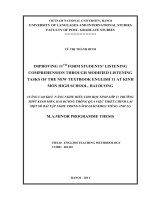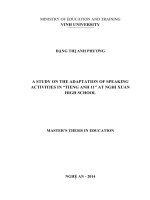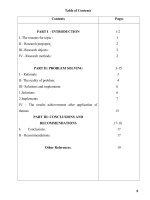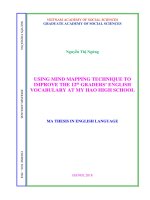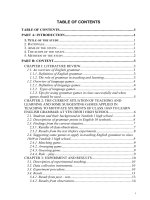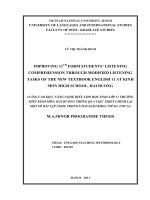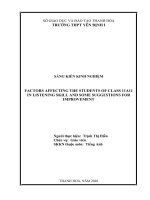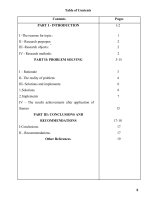Using some games to motivate the students of class 10a9 to learn english grammar at yendinh 1 high school
Bạn đang xem bản rút gọn của tài liệu. Xem và tải ngay bản đầy đủ của tài liệu tại đây (266.14 KB, 34 trang )
TABLE OF CONTENTS
TABLE OF CONTENTS.....................................................................................I
PART A: INTRODUCTION...............................................................................1
1. TITLE OF THE STUDY.....................................................................................1
2. RATIONALE.....................................................................................................1
3. AIMS OF THE STUDY.......................................................................................1
4. THE SCOPE OF THE STUDY..............................................................................1
5. METHODS OF THE STUDY................................................................................2
PART B: CONTENT...........................................................................................3
CHAPTER I: LITERATURE REVIEW............................................................3
1.1. An overview of English grammar............................................................3
1.1.1. Definition of English grammar..........................................................3
1.1.2. The role of grammar in teaching and learning..................................3
1.2. Overview of language games...................................................................4
1.2.1. Definition of language games............................................................4
1.2.2. Types of language games..................................................................4
1.2.3. Tips for using grammar games in class successfully and when
games should be used...................................................................................5
CHAPTER 2: THE CURRENT SITUATION OF TEACHING AND
LEARNING AND SOME SUGGESTING GAMES APPLIED IN
TEACHING TO MOTIVATE STUDENTS OF CLASS 10A9 TO LEARN
ENGLISH GRAMMAR AT YEN DINH I HIGH SCHOOL.............................6
2.1. Students and their background at Yendinh 1 high school........................6
2.2. Descriptions of grammar points in English 10 textbook.........................6
2.3. Findings from the current situation.........................................................7
2.3.1. Results of class observation...............................................................7
2.3.2. Results from the test (before experiment)...........................................8
2.4. Suggesting some games to apply in teaching English grammar to class
10A9 at Yendinh 1 high school.......................................................................8
2.4.1. Matching game...................................................................................9
2.4.2. Arranging game.................................................................................9
2.4.3. Guessing game...................................................................................9
2.4.4. Role – play.........................................................................................9
CHAPTER 3: EXPERIMENT AND RESULTS..............................................10
3.1. Description of experimental teaching....................................................10
3.2. Data collection instruments...................................................................10
3.3. Experiment procedure............................................................................10
3.4. Result.....................................................................................................13
3.4.1. Result from post – test......................................................................13
3.4.2. Results from observation..................................................................14
i
3.5. Findings.................................................................................................15
CHAPTER 4. SUGGESTED SOLUTIONS...................................................16
4.1. For the teachers.....................................................................................16
4.1.1. Preparing a well-planned lesson with an interesting game.............16
4.1.2. Organizing the language games in class.........................................16
4.1.3. Giving games with clear instructions..............................................16
4.1.4. Providing games with support.........................................................17
4.2. For the students.....................................................................................17
PART C: CONCLUSION.................................................................................18
1. SUMMARY OF THE STUDY.............................................................................18
2. SUGGESTIONS FOR FURTHER RESEARCH......................................................18
APPENDIX...........................................................................................................I
APPENDIX 1: REFERENCES..........................................................................I
APPENDIX 2: PRE- TEST (BEFORE EXPERIMENT)..................................II
APPENDIX 3: POST- TEST (AFTER EXPERIMENT).................................IV
APPENDIX 4: CLASS OBSERVATION........................................................VI
APPENDIX 5: LESSON PLAN 1..................................................................VII
APPENDIX 6: LESSON PLAN 2.....................................................................X
APPENDIX 7: LESSON PLAN 3..................................................................XII
ii
PART A: INTRODUCTION
1. Title of the study
Using some games to motivate the students of class 10A9 to learn English
grammar at Yendinh 1 high school
2. Rationale
In recent years, English has become more and more popular in the world.
In different countries, different people at different ages learn English for their
own purposes. In Vietnam, learning English language is interested by young
people, especially students for a plenty of reasons such as studying at good
universities, studying abroad and so on.
In studying languages in general and studying English in particular, it can
be said that grammar seems to be difficult and boring for students. It is thought
by students that English grammar contains complex, difficult, and different
rules. Besides, traditionally, many teachers approach grammar teaching very
seriously, making the lessons dull and uninteresting. Therefore, students usually
feel tired and bored during grammar lessons and then they are not motivated to
study. William Somerset Maugham (1938) indicated that “it is necessary to
know grammar, and it is better to write grammatically, and it is well to
remember that grammar is common speech formulated”, “grammar is the
structural foundation of our ability to express ourselves. The more we are aware
of how it works, the more we can monitor the meaning and effectiveness of the
way we and others use language. It can help foster precision, detect ambiguity,
and exploit the richness of expression available in English”. Therefore, we can
see that English grammar plays an integral role in learning English.
For some reasons above and with the desire to create interest for students
in English grammar lessons, especially students in class 10A9 at high school, I
really want to clarify the topic : “Using some games to motivate the students of
class 10A9 to learn English grammar at Yendinh 1 high school”.
3. Aims of the study
The first purpose is to investigate the current situation of teaching and
learning English grammar to the class 10A9 at Yendinh 1 High School. Based on
the current situations and results got from investigating the effectiveness of
using language games, the author proposes some solutions to improve the
effectiveness of teaching – learning English grammar.
The second purpose is to demonstrate the effectiveness of applying the games
in teaching English grammar to grade 10 in general and to class 10A9 at
Yendinh 1 high school in particular.
4. The scope of the study
Because of the limited time, the study only focuses on the application of
some typical games in teaching English grammar to class 10A9 especially for
some structures such as: To+infinitive; Attitudinal adjectives, and Will vs going
1
to. Moreover, these grammatical contents in the basic “Tieng Anh 10” textbook
coincided the time the researcher worked as a student teacher in class 10A9 at
Yendinh 1 high school, so it is very convenient to study.
5. Methods of the study
- Consulting related materials: For the sake of getting knowledge and
useful ideas, I read many books and other materials in addition to earlier
researches about using language games when teaching grammar for students.
- Test and observing teaching grammar lessons: To fulfill this study, the
researchers observed class 10A9 in teaching and learning grammar lessons in
the second semester in school year 2018- 2019 in order to find out the
effectiveness of using games when applied in teaching and learning English
grammar, then two tests were dilevered to students before and after experiment
to check the results of the techiques that the researcher used in the experiment.
- Analyzing the statistics from the observation and tests.
2
PART B: CONTENT
CHAPTER I: LITERATURE REVIEW
1.1. An overview of English grammar
1.1.1. Definition of English grammar
Crystal (2004) defined: “Grammar is the structural foundation of our
ability to express ourselves. The more we are aware of how it works, the more
we can monitor the meaning and effectiveness of the way we and others use
language. It can help foster precision, detect ambiguity and exploit the richness
of expression available in English. Additionally, it can help everyone, not only
teachers of English, but teachers of anything for all teaching. Grammar is
ultimately a matter of getting to grips with meaning”.
Ur (1991) also said that “the way language manipulates and combines
words (or bits of words) in order to form longer units of meaning”. This
definition is quite close to the common understanding of what grammar is. The
main difference is that it tells us how the rules of languages actually work- they
arrange and shape words. Nevertheless, knowing what these rules do is not a
very motivating factor alone.
1.1.2. The role of grammar in teaching and learning
Harmer (1987) pointed out: “Without some understanding of grammar,
students would not be able to do anything more than utter separate items of
language for separate functions.”.
Grammar, in the first place, helps students understand how the language
works. Apart from vocabulary, students need to know grammar to understand
how it is written or how words are combined together to understand the proper
meaning. Without grammar or with a poor knowledge of grammar, they may get
confused with complicated expression.
Second, Smith (2001: 15) claimed that if teachers neither pay attention to
grammar nor create opportunities for learners to improve grammar, learners are
likely to stand the risk of fossilization or reach a point where they can cope with
level of communication that is demanded of them by making use of their
existing grammatical resources and communication strategies and probably with
sufficient fluency. Surely, they do not see the need to develop their linguistic
abilities any further.
In favor of the importance of grammar, Larsen – Freeman (1986:13)
affirmed that grammar is regarded as a skill rather than an area of knowledge.
Learners do not simply store knowledge about the language and its use, they
need also develop an ability to do something. They must have a chance of
learning situations to overcome the knowledge problem. It is true to say that
grammar is the fifth skill besides four skills reading, writing, speaking, and
listening. Skill development as well as learning grammar takes practice.
3
Grammar might not be taught only when the students already possessed the
knowledge and the ability to use the grammar item in speech, writing and
listening comprehension. In fact, grammar is the basis for mastering four
language skills. When we have concrete foundation of grammar, we feel easy to
advance.
1.2. Overview of language games
1.2.1. Definition of language games
Games are forms of entertainment derived from a set of artificial rules,
typically with a known goal to be reached. Games can be in the form of physical
activities, mental, or a mixture of the two. Also, games can be classified as
cooperative, solitaire or competitive. Rixon (1981) claimed that “a game
consists of play governed by rules”. This was summed up very well in Gibb’s
definition (1978) of a game as “an activity carried out by cooperating or
competing decision markers, seeking to achieve, within a set of rules, their
objectives.”
Language games mean games related to language. If games help to
improve different aspects such as intellectual ability, patience, then language
games help to develop language skills. When playing these language games,
students not only have fun but can also practice English enjoyably, which helps
to motivate students. Greenal (1984) defined as “one kind of activity which is
used to consolidate language already taught or acquired and occurs during the
free stage of lesson or during occasions such as English club meeting…”
1.2.2. Types of language games.
Hadfiled (1987) stated that: “language games can be divided into two further
categories: Linguistic games and communicative games. Linguistic games focus
on accuracy, such as applying the correct antonym. On the other hand,
communicative games focus on successful exchange of information and ideas,
such as two people identifying the differences between their two pictures which
are similar to one another but not exactly alike”. Hadfield (1987) also classified
language games into many more categories as follows:
Sorting, ordering or arranging games. For example, students have a set of
cards with different products of them, and they sort the cards into products
found at a grocery store and products found at a department store.
Guessing games: In these games, someone knows something and the others
must find out what it is. One of the best known examples of a guessing game is
20 Questions, in which one person thinks of a famous person, place, or thing.
The other participants can ask 20 Yes/No questions to find clues in order to
guess who or what the person is thinking of.
Matching games: As a name applies, participants need to find a match for a
word, picture or card.
4
Exchanging games: In these games, students barter cards, other objects, or
ideas. Similar are exchanging and collecting games. Many card games fall into
this category.
Labeling games: These are form of matching, in which participants match
labels and pictures.
Role play games: The terms role play, drama and simulation are sometimes
used interchangeably but can be differentiated. Role play can involve students
playing roles that they do not play in real life, such as dentists, while simulations
can involve students performing roles that they already play in real life or might
be likely to play, such as a customer at a restaurant. Dramas are normally
scripted performances, whereas in role plays and simulations, students come up
with their own words, although preparation is often useful.
1.2.3. Tips for using grammar games in class successfully and when games
should be used
First, mentioning using games in class successfully, Nedomová (2007: 19)
pointed out, “teachers should consider whether the game-like activity is for
children only to make the lesson more attractive and protect them from being
bored or whether we tend to revise and practice some particular part of grammar,
vocabulary, etc.” Moreover, teachers need to consider the level of the games
before applying them into lessons. If the game is suitable for students’ language
level, they will feel happy and take part in enthusiastically. However, if the game
is too easy or too difficult, they will feel boring and will not want to enjoy
playing the game. In addition, it can be easily realized that games help to
enhance social interaction and participation from students. Therefore, teachers
should understand students’ favourites and if they can learn best with games
which require physical action interaction, competition and participation. And
then, teachers can use the games which can both maintain pedagogical values
and satisfy students. Other factors such as the size and the physical properties of
the classroom, the equipment, materials and the time available for a game
(McCallum,1980, p.xii) also need paying attention to by teachers.
Second, mentioning when games should be used in the lesson, Rinvolucri
(1990) concluded that games can be used in any stage of a lesson. Particularly,
games can be implemented:
a) before presenting a given structure, especially to find out diagnostically
how much knowledge is already known by the learners.
b) after a grammar presentation to see how much the group have grasped.
c) as a revision of a grammar area.
5
CHAPTER 2: THE CURRENT SITUATION OF TEACHING AND
LEARNING AND SOME SUGGESTING GAMES APPLIED IN
TEACHING TO MOTIVATE STUDENTS OF CLASS 10A9 TO
LEARN ENGLISH GRAMMAR AT YEN DINH I HIGH SCHOOL
2.1. Students and their background at Yendinh 1 high school
The study was carried out to investigate the current situation of
teaching and learning English grammar to class 10A9 at Yendinh 1 high school.
Class 10A9 has 44 students, include 17 boys and 27 girls. All the students in
class have similar backgrounds such as come from villages in Yendinh district
such as Dinh Hai, Dinh Tien, Dinh Hoa…. They have already finished
secondary school with four years of learning English. Although they have had
for over four years of learning English, their English proficiency has been very
low. Besides, learning environment is very important, too. When being asked
why students at Yendinh 1 high school are not good at English, most of the
teachers agreed that they did not have good environment. English seems never
to be used outside class. Especially, English grammar is not often practiced in
the class, except the Language focus lessons. Furthermore, in English lessons,
English is used much by teachers and good students, the others are lazy or
reluctant to practice and do exercises because they have no effort and aim to
learn. Some are afraid of talking as they fear to make mistakes and lose face,
and sometimes they fear to get bad marks and be paid bad attention from
teachers. Also, English grammar is complicated and difficult to remember, so
most of the students are not interested in learning.
2.2. Descriptions of grammar points in English 10 textbook
English grammar is mentioned in the Language focus lesson of each unit
(from unit 1 to unit 16). Each unit provides students with different grammatical
knowledge:
Unit 1: The present simple, Adverbs of frequency, The past simple
Unit 2: Wh - questions, Gerund and to + infinitive
Unit 3: The past perfect, The past perfect vs The past simple
Unit 4: The + adjective, Used to + infinitive, Which as a connector
Unit 5: The present perfect, The present perfect passive, Who-Which-That
Unit 6: The present progressive (with a future meaning), Be going to
Unit 7: The present perfect, Because of and inspite of
Unit 8: Reported speech (statements), Conditional sentence type 1
Unit 9: Should, Conditional sentence type 2
Unit 10: The passive voice
Unit 11: Conditional sentence type 3
Unit 12: To + infinitive to talk about purposes, Wh - questions
Unit 13: Attitudinal adjectives, It is/ was not until.... that..., a/ an and the
Unit 14: Will vs Going to, Will: making predictions, Will: making offers
6
Unit 15: Non - defining vs defining relative clauses, Although as a
contrasting connector
Unit 16: Comparatives and superlatives, Making comparisons
Language focus lesson is the last lesson in each unit introduced after four
skill lessons are Reading, Speaking, Listening and Writing, often includes two
parts: Pronunciation and Grammar. English grammar is a difficult content in
English lessons and it is not interesting for students. Therefore, an effective
technique should be exploited to motivate students in these grammar lessons.
Because of the limited time and conditions, the researcher only applied some
games for some grammar lessons within the scope of unit 12 - unit 14
2.3. Findings from the current situation
To find out some current situations in using language games in teaching
English grammar in class 10A9 at Yendinh 1 high school, the researcher surveys
the current situations by using observation and tests. The researcher found out
some following results.
2.3.1. Results of class observation
During the experiment, the researcher observed three different English
grammar lessons of class 10A9 without using games, two periods in the
afternoon review and one periods in the main course time in the morning to see
the students’ attitude in class. The observation worksheet has two parts: the first
part presents information about name of the teacher, time teaching, date of
teaching, level of students and the second states students’ attitude about English
grammar periods such as preparation at home, attention in the class,
participation in activities and frequency in building the lessons. The observation
is presented at the Appendix 4.
Results from the teacher
In English grammar lessons, the teacher ussually used the method
“presentative approach” in their lessons, the teacher used extra-boards, handouts
in English grammar lessons. However, the applying new teaching technique
hasn’t been done effectively yet.
Moreover, the teacher did not use any grammar games during the lesson.
It made the classroom’s atmosphere become stressful. Students showed their
tiredness in class, both teachers and students felt tired after the lessons, students
were very passive, not enthusiastic in expressing their opinions. In the lessons,
teacher mostly used Vietnamese to make sure that all the students in the class
understood about the lessons.
Results from the students
In my observation, I realized that most of the students seldom raised their
hands in lessons. They were not willing to practice. They only practised when
being asked. More than half of the students prepared for the lesson before going
to class, while a small number of students who do not prepare their homework,
so when they are asked they could not give the answer. Some students prepared
7
the homework but were not well-prepared. So they were still hesitant when the
teacher asked about the content of the lessons.
When working in groups, it was very often that just one or two students
worked while other students did other activities such as chatting with each other,
using the mobile phone, etc. In addition, in my observation, I saw that when
using English grammar, most students did not care about whether the structure
was used correctly or incorrectly, or to mix up the structure with other
structures.
Moreover, most of the students felt unconfident when being asked to
practice the English grammar structures such as giving examples or doing
exercises. They showed their worries; nobody wanted the teacher to call him to
practise.
2.3.2. Results from the test (before experiment)
Before applying English grammar games in the experiment process, the
author gave a mini - test for the students of class 10A9, including the content:
“To+infinitive; Attitudinal adjectives; Will and be going to”. The total students
in class are 44 students. The specific content of the test is shown in Appendix 2.
After giving the exercises to the students, the researcher got the following results:
No
Mark
Result
Number of students
%
1
8 10
2
4.6
2
7 7.9
4
9.1
3
5 6.9
26
59.1
4
<5
12
27.2
Table 1. Result of the test before experiment
From the table 5 above, only two students got the very good marks
(810), account for 4.6%.
9.1% of the students (4 students) got 77.9 (good marks).
Most of the students (26 students) got 56.9 (average marks), account for
59.1%.
27.2% of the students (12 students) got under 5 (poor marks).
As we can see, the effectiveness of the lessons before experiment was not
good and the score for the test is not high. Only a few students got high marks
and a lot of students got poor marks. It is necessary to find out a technique to
improve the effectiveness of the grammar learning lessons.
2.4. Suggesting some games to apply in teaching English grammar to class
10A9 at Yendinh 1 high school
In this part, the researcher gives some suggested games to apply in
teaching English grammar in the experimental process in class 10A9 at Yendinh
1 high school. The purpose of this experiment is to assess the effectiveness of
using the game in teaching English grammar to class 10A9 at Yendinh 1 high
school and create excitement for students learning English grammar.
8
Because of time, level of students, content of each lesson and the research
purpose, the researcher can not do experiment with all English grammar games.
The researcher suggests some following types of language games such as:
Matching game; Arranging game; Guessing game and Role-play. They are
typical grammar games to improve English grammar because the results of
previous researches showed that they are effective to teaching – learning English
grammar. These solutions were put into practice through experimental teaching.
The results of these experimental teaching and some discussions are mentioned
at the end of this study.
2.4.1. Matching game
When doing experiment, this game will be organized at the warm - up
stage of Unit 12: Music – Language focus. It was applied to experimental
teaching “To+infinitive”. Its procedure will be presented more specifically in
chapter 3.
2.4.2. Arranging game
This is the game that the researcher designed and applied for
“To+infinitive” structure in Unit 12: Music - Language focus (Exercise 2) at
practice stage. Its procedure will be presented more specifically in chapter 3.
2.4.3. Guessing game
“Guessing game” will be used at the production stage of Unit 13: Films
and cinema – Language focus: Attitudinal adjectives. The purpose of the game
is to help students review some adjectives of attitude. Its procedure will be
presented more specifically in chapter 3.
2.4.4. Role – play
It will be applied to “Will & going to” in Unit 14: The world cup. This
type of game will be organized at the Practice stage (Exercise 1). Its procedure
will be presented more specifically in chapter 3.
Above are some suggested games that will be used during the experiment,
each game is applied in different sections, lessons in different units. The process
and content of the games will be presented in chapter 3 of the study.
9
CHAPTER 3: EXPERIMENT AND RESULTS
In the previous chapter, the researcher provided some suggested games to
apply in teaching English grammar to class 10A9 at Yendinh 1 high school. In
this chapter, the researcher would like to conduct an experiment to check the
feasibility of some suggested solutions.
3.1. Description of experimental teaching
The researcher had 3 weeks to carry out the experiment in class 10A9.
The researcher applied some grammar games to teach English grammar to
students in class 10A9. The English teachers of class 10A9 at Yendinh 1 high
school helped me to carry out the experiment in applying some games in 3
weeks.
3.2. Data collection instruments
In order to know whether using some grammar games for learning
English grammar is effective or not, the researcher carried out an experiment.
This experiment is necessary for the researcher to give the most exact results in
this study.
A test after experiment was used to check the improvement of the students
in class 10A9 about English grammar (Appendix 3).
Obervation worksheet was used to observe teacher and students’ activities
and their attitude towards the lessons
3.3. Experiment procedure
Basing on the results from the current situations and some suggested
solutions, the researcher did experimental teaching. The experimental teaching
included three parts: warm – up, practice and production. The researcher chose
some games such as: Matching game; Labeling game; Guessing game and Roleplay because these games are easy to play and easy to organize in the classroom,
it can apply for different lessons and different grammatical structures. Some
grammar games in each part were used separately because of the differences
among contents of each unit. The researcher did experimental teaching in
English grammar in three units: Unit 12: Music, Unit 13 Films and cinema and
Unit 14: The World cup. In the process of organizing the games, the teacher
went around the class, helped the students when they had difficulties, especially
the students would receive a small gift if they gave correct answers. The
procedure of experiment lasted 3 weeks with the list of works as following:
The first week
In the first week, the researcher carried out two grammar games:
Matching (at the warm – up stage of Unit 12) and Lableling game (at the
practice stage of Unit 12) for the grammar structure “To+infinitive”.
A warm up activity is often a short and fun game which the teacher can
use with his/her students. The purpose of warms up is to prepare them to learn
by stimulating their minds. Warm ups should last about five minutes.
10
Unit 12: Music (Warm – up)
Type of games: Matching game
Class management: Group work
Material: handouts
Time: 3-5 minutes
* Procedure:
- The teacher prepares a handout include two columns: the first column contains
the first half of a sentence and the second contains the other half.
- Teacher divides the whole class into two big groups.
- Ask students to work in groups, read and match the content of column A with
the appropriate content in column B. Each team has only one minute to think
about the answers, after a minute the team raised their hands first will have the
right to give the answer. If the answer of the first team is wrong, the right answer
belongs to the other team.
- The team that has the best and fastest answer will be the winner and receive a
gift from the teacher.
Handout
A
B
1. She went to London last week
a. to practice speaking English in my
class.
2. She speaks English every day
b. to communicate with foreigners.
3. I do not have chance
c. to give his girlfriend on her birthday.
4. Nam wants to buy a special gift
d. to have a opportunity to study abroad.
5. Hoa wished to pass this exam
e. to visited a her friend.
The practice stage is the main part of a grammar lesson in which students
use English grammar stuctures provided in presentation stage to do exercises or
practice. Time spent on this stage is about twenty to twenty-five minutes.
Unit 12: Music (Practice – Exercise 2)
Type of games: Arranging game
Class management: Whole class
Material: handouts, cards
Time: 5-7 minutes
* Procedure:
- Teacher prepares some cards contain the lack words of the sentences in
Exercise 2 (textbook, page 131) and some handouts contain the sentences in
textbook and then pick up on the board. The order of the sentences and the
missing words to be filled are not arranged in the order.
- Teacher asks students to work individual, quickly read and then match the
words in the cards with the suitable sentences in the handouts.
- The teacher would ask the students who raised his/her hand earliest to go to the
board to match these words with the suitable sentences, and the others orally
answer. Students who have the correct answers and the fastest will receive a
11
special gift or get mark from teacher. If the student answers wrong, the right
answer belongs to another student.
- During the grammar game, the teacher often encourages the students to get
high mark or a special gift.
- Students play the game until they complete all the sentences in Exercise 2.
- Teacher evaluates the results of students and laud positive students to have the
correct answers, encourage the pairs who have incorrect answers.
Handouts
Cards
1. My father didn't have time _______ the
to study/ learn
newspaper
2. I wish 1 had enough money_______ a new
to invite
bicycle.
3. I went to the post office_______ a letter.
to read
4. He telephoned_______ me to the party.
to buy
5. She’s going to Britain_______ English.
to post
The second week
In the second week, the researcher carried out the grammar game:
Guessing game for “Attitudinal adjectives” in Unit 13 in the basic English 10
book.
Production is the last step of a grammar lesson so it is time for students’
production. The activities in this stage are for students to reflect upon their
performance. Production stage should last seven to ten minutes.
Unit 13: Films and cinema (Production)
Type of games: Guessing game
Class management: Group work
Material: cards
Time: 7-10 minutes
* Procedure:
- The teacher prepares ten small cards, which contain the attitudinal adjectives
(each card is an adjective).
- Teacher divides the class into two teams.
- Teacher call on one student as a describer to go to the board to describes some
attitudinal adjectives are given by the teacher (just only describe in action, not
using words).
- The memmbers of two team look at the describer and guess what is the word.
- The team, who has more correct answers, is the winning team and receive a
teacher’ gift.
Attitudinal adjectives
1. Shocking/ shoked
6. exciting/ excited
12
2. boring/ bored
7. tiring/ tired
3. worrying/ worried
8. fascinating/ fascinated
4. frightening/ frightened
9. disgusting/ disgusted
5. surprising/ surprised
10. confusing/ confused
The third week
In this week, the researcher carried out the language games: Role – play
(at the practice stage of Unit 14) for the structure “Will vs going to”.
Unit 14: The World cup (Exercise 1)
Type of games: Role-play
Class management: Pair work
Material: textbook
Time: 5-7 minutes
* Procedure:
- After revising the theories of “Will and Going to”, the teacher introduces and
gives the rules of the game.
- Teacher asks students to work in pairs to play this game. One student is
speaker A and other is speaker B. The teacher would ask the first pair who raised
their hand to role – play. If they give a correct answer, they would get a mark or
a small gift; especially, if they give the correct answer, they have the rights to
choose two others to continue the game. In opposite, the pairs have incorrect
answers will be penalized by dancing or singing.
- The teacher does the same with the other groups. During the language game,
the teacher often encourages the students to get high mark or a special gift.
- Students answer respectively until complete all the sentences.
- Teacher evaluates the results of these pairs and lauds positive pairs to have the
correct answers, encourages the pairs who have incorrect answers.
3.4. Result
To find out some results in using grammar games in teaching English
grammar in class 10A9 at Yendinh 1 high school, the researcher did
experimental teaching. During these lessons, the researcher observes all
teacher’s activities as well as students’ activities. Besides, the researcher asked
students to take a mini post-test (appendix 3). The researcher found out some
following results.
3.4.1. Result from post – test
To evaluate the improvement of the students after experiment, the author
designed a mini post - test with experimented teaching. The content of the posttest was designed as a pre-test to ensure objectivity and easy to see the
differences in teaching English grammar before and after the experiment,
including: To+infinitive; Attitudinal adjectives; and Will vs. going to. The
specific content of the test was shown in Appendix 3.
No
Mark
Result
13
Students
%
1
8 10
8
18.2
2
7 7.9
15
34.2
3
5 6.9
16
36.3
4
<5
5
11.3
Table 2: Result of the test after experiment
From the table 7 above, 8 students got the very good marks from 810,
account for 18.2% while only two student got the same marks from 810
before experiment (4.6%). Obviously, a number of students got the very good
marks increased.
34.2% of the students (15 students) got 77.9 (good marks) while only 4
students got the mark 77.9 (9.1%) before experiment. A number of students
got the good marks increased.
36.3% of the students (16 students) got 56.9 (average marks) while 26
students got the average marks before experiment (59.1%). A number of
students got the average marks decreased.
11.3% of the students (5 students) got under 5 (poor marks) while 12
students got poor mark before experiment (27.2%). A number of students got the
poor mark decreased.
The comparison between pre test and post test is shown in the table
below:
Marks
Results
Before experiment
After experiment
Number of
%
Number of
%
students
students
8 10
2
4.6
8
18.2
7 7.9
4
9.1
15
34.2
5 6.9
26
59.1
16
36.3
<5
12
27.2
5
11.3
Table 3: The comparison between pre-test and post-test
As we can see, the effectiveness of the lessons after experiment was
improved. The number of the students got high marks increased and the number
of students got poor marks decreased.
3.4.2. Results from observation
During experimental teaching lessons, I observed the students’ attitude
towards the lesson and realized that many students raised their hands to
contribute to the lessons. Nobody slept in class. The teacher used target
14
language to present knowledge. The teacher only used Vietnamese when there
were some difficult words or structures.
The students were asked to work in pairs or groups basing on the content
of each task. In these lessons, the teacher used handouts and cards in grammar
games. The teacher taught English grammar through the games. As a result,
students were very interested in the lessons. They showed their excitement about
these teaching aids and teacher’ teaching methods. Thanks to these teaching aids
and teacher’ methods, students contributed to the lessons very well. The class’s
atmosphere became interesting.
According to the researcher’s observation, in lessons that teachers used
language games, students not only contributed to the lessons but also used
English grammar well and correctly. They showed their confidence in their
practice. In addition, after the lessons, students often discussed what they
learned.
Moreover, all of the members in group and all students in class worked,
nobody sat in silence as they used to. We can see that when all students work
actively, they will understand the content of the lessons more deeply; the
classroom’s atmosphere becomes more interesting. Taking part in some games
will help students improve their English grammar and feel more confident.
3.5. Findings
From the results of students’ feedback questionnaire, post - test, and
observation the researcher found out some findings about the effectiveness of
using grammar games in teaching English grammar to class 10A9 at Yendinh 1
High School after experiment.
After applying some games in teaching English grammar in class 10A9 at
Yendinh 1 High School, most of the students felt interested in grammar lessons.
The classroom’s atmosphere is more relaxed and comfortable; it makes students
are keen on the lessons. They are more interested in practising English grammar
than ever before. Many students raised their hands to take part in the games and
to practice. Especially, nobody slept in the lesson.
The use of games in teaching English grammar greatly improves the use
of English grammar structures of the students. They are more active in learning
English grammar. The researchers have applied some games in teaching some
grammatical structures such as: To+infinitive; Attitudinal adjectives; and Will vs
going to. After the experimental teaching, especially after the results of the tests,
the researcher realized that the class 10A9 students’ use of the English grammar
structures was better and more effective. In general, the post - test scores of the
students are higher than pre-test. In addition, during the use of the games in
experimental teaching, the researcher observed that students are more active in
the use of grammatical structures, although there are students who say wrong,
misuse stuctures, but it only accounts for a small amount. But that also
demonstrates that the students’ use of English grammar has improved.
15
CHAPTER 4. SUGGESTED SOLUTIONS
Through analysis and discussion of the data collected from observation
and test as well as the significant findings, the researcher was revealed the
research issues. When teaching grammar for Yendinh 1 high school students in
general and students in class 10A9 in particular, teachers need to carefully
prepare. When organizing games while teaching grammar, teachers need to
select the appropriate game content to teach, estimate and allocate appropriate
time to ensure the quality of teacher’s teaching.
For the grammatical structures experimented (To+infinitive; Attitudinal
adjectives, and Will vs going to), the researcher prepared simple handouts and
cards to support the games. After reviewing the theory learned at the lower
levels, the researcher helps the students to practice through the games to create a
sense of comfort and excitement for the students.
Based on the theoretical background and findings of the study, the
following suggestions are useful for solving the problems and for the better use
of some typical classroom activities improve English grammar for the students
in class 10A9 at Yendinh 1 high school.
4.1. For the teachers
It is essential that the teachers should pay great attention to teaching
English grammar. Teachers should use many kind of classroom language games
to make students more interested in English grammar. In order to make the
classroom’s atmosphere more effective, the teachers should take into
consideration the following recommendations:
4.1.1. Preparing a well-planned lesson with an interesting game
A well-planned lesson is always necessary to contribute to the effectiveness of
classroom activities, especially the grammar games. When choosing any
grammar game, the teacher should note some things: the purpose and
organization of the games, the length of the lesson and the students’ ability level.
Moreover, preparing good materials for the lessons will help the teachers
practise well in class.
4.1.2. Organizing the language games in class
The teacher should decide in advance how to organize class so that the settings
up of a language game can be conducted as quickly and smoothly as possible. In
one class there will be different students with personalities and different points
of view, so this way of forming group may be appropriated for some students
but may not be ideal for others. Hence, teachers should be flexible in organizing
group work and pair work in class so as to satisfy most of their students’ needs
and interests at different times. To sum up, an individual teacher should decide
himself/herself what work arrangement would best suit his/her students in the
concrete situation.
4.1.3. Giving games with clear instructions
The teachers must ensure that the students understand what the task involves,
what its goals are and what outcome are required. If the students can not
16
understand, the teachers have to simplify the explanation and does each step
gradually as models until all the students get to the point. As the teachers’ giving
instructions in a class is very essential, they should be simple, precise and
explicit. In short, what the teacher does at this stage is to provide a good model
of the grammar games for his/her students to do smoothly.
4.1.4. Providing games with support
Due to the students’ low level of English grammar, the teachers should give
praise to the students in any achievement; the teachers make and assure students
that they can succeed with learning as long as they try their best. When the
students are working in groups, pairs or individuals, the teachers should
circulate around classroom to ensure that the students are on the right track and
see whether they need help. The teachers should give corrective feedback on the
students’ performance at the end of the task or at any stages of the game in order
to avoid distracting students.
4.2. For the students
Learning English grammar is not difficult if the students have positive
attitude towards it. In the class, the students must co-operate with the teachers
and partners by paying attention and taking part in the grammar games
enthusiastically and at home, they should spend much more time to do English
grammar exercises, create oneself confidence when using grammar structures in
front of many people.
Furthermore, the most important thing to deal with the students is that
they should be aware of the benefits of the grammar games. In addition, the
students should be responsible for their English learning. Instead of being
passive in the class, they are expected to join all the grammar games conducted
by the teachers voluntarily and actively.
17
PART C: CONCLUSION
1. Summary of the study
Basing on theoretical base of English teaching grammar, surveying the
fact and doing experimental teaching, the researcher found out some current
situations as well as some results after doing experimental teaching.
This study is done with the purpose of seeking the effective teaching
technique to increases the motivation and efficiency of learning English
grammar for class 10A9 students. And this study consists of many teaching
techniques exploited by teachers to teach English grammar.
The literature review has been made in the hope of demonstrating the
scope of the study theoretically in terms of English grammar and grammar
games. The findings from the data analysis show students have low motivation
towards English grammar, they are less interested in learning English grammar
in the class, they find English grammar either challenging or boring. Thus they
show their unwillingness to raise their hands to give their opinion. Therefore, a
teaching technique, grammar games, is tested whether they can improve
students’ motivation in grammar lessons. And according to students’ attitudes,
perspectives and preferences, language games are applicable as a motivator in
English grammar lessons.
2. Suggestions for Further Research
In this study, I have found out some current situations in teaching English
grammar in class 10A9 at Yendinh 1 High School, and then suggest some games
to assess the differences of teaching English grammar when using games and not
using games. In addition, some suggested games were used to motivate students
toward learning English grammar. This study, the researcher only studies in
English grammar lessons.
Due to the shortage of time, students’ limit of knowledge and the scope
of the study, the study can not cover all the uses of English grammar games.
Therefore, further study also focuses on the use of further grammar games as a
motivator in teaching and learning English grammar classes.
18
XÁC NHẬN CỦA THỦ TRƯỞNG
ĐƠN VỊ
Thanh Hóa, ngày 20 tháng 5 năm
2019
Tơi xin cam đoan đây là SKKN của
mình viết, không sao chép nội dung
của người khác.
(Ký và ghi rõ họ tên)
LƯU THỊ LAN
19
APPENDIX
APPENDIX 1: REFERENCES
1. Hoàng Văn Vân, Hoàng Thị Xuân Hoa, Đào Ngọc Lộc, Vũ Thị Lợi, Đỗ Tuấn
Minh, Nguyễn Quốc Tuấn. Tiếng Anh 10, NXB Giáo Dục Viet Nam.
2. McDough, J & Shaw, C. (1993). Materials and Methods in ELT. Blackwell.
3.Andrew Wright, A., Betteridge, D., & Buckby, M. (1994). Games for
language learning. Cambridge: Cambridge University Press.
4. Saricoban, Arif and Esen Metin. (2000), Songs, Verse and Games for
Teaching Grammar. iteslj.org/Techniques/Saricoban-Songs.html.
5. Harmer, J. (1987), Teaching and Learning Grammar. Longman Group UK
Ltd.
6. Lin Hong (1932), Teaching grammar with games in the ESL classroom
7. Wright, A., Betteridge, D., & Buckby, M. (1984), Games for language
learning (2nd ed.). Cambridge: Cambridge University Press.
8. Crystal, D (2004), Rediscover grammar. London: Sage Publication.
9. Rinvolucri, M. (1990), Grammar games: Cognitive, affective and drama
activities for EFL students. Cambridge: Cambridge University Press.
10. Rixon, S (1981), Young learners of English: Some research perspectives.
London: Longman.
Website
1.
/>es_in_the_ESL_Classroom.htm
2.
/>3. />
I
APPENDIX 2: PRE- TEST (BEFORE EXPERIMENT)
I. Rewrite the following sentences using an infinitive.
1. It won’t be any good my talking to him about it.
=>............................................................................................................................
2. It is no use trying to convince him of this.
=>............................................................................................................................
3. It wouldn’t be much good complaining to the minister about it.
=>............................................................................................................................
4. It was a difficult business starting the car with such a weak battery.
=>............................................................................................................................
5. It is no fun having so many children to look after.
=>............................................................................................................................
II. Complete the sentences with the suitable “-ed”, “-ing” form of the words
in brackets.
1. The book I’m reading is really _______.
(Interest)
2. The girl was ______ about her coming birthday party.
(Excite)
3. The story I just finished had a very ______ ending.
(Surprise)
4. The characters in the story are _______.
(Fascinate)
5. I’m _______. I can’t understand the instructions on this box. (Confuse)
III. Put the verb in bracket into the concert form: WILL & BE GOING TO
1. There (be) …………………. areally big storm in a few hours.
2. Look out! She (faint) ………………….
3. I (practice)………………………… the piano for two hours this evening.
4. We’re lost I (stop) ………………. and ask the way.
5. I (be) ……………… a teacher of English when I grow up
II
Answer keys:
I.
1. It won’t be any good for me to talk to him about it.
2. It is no use for us to try to convince him of this.
3. It wouldn’t be much good for us to complain to the minister about it.
4. It was a difficult business for me to start the car with such a weak battery.
5. It is no fun for me to have so many children to look after.
II.
1. interesting
4. fascinated
2. excited
5. confused
3. surprising
III.
1. There (be) will be areally big storm in a few hours.
2. Look out! She (faint) is going to faint.
3. I (practice) am going to practice the piano for two hours this evening.
4. We’re lost I (stop) will stop. And ask the way.
5. I (be) am going to be a teacher of English when I grow up.
III
APPENDIX 3: POST- TEST (AFTER EXPERIMENT)
I. Join together the following sentences by using infinitives.
1. He went to the market. He wanted to buy some vegetables.
.....................................................................................................................
2. The robber wielded a knife. He intended to frighten the poor traveler.
.....................................................................................................................
3. I speak the truth. I am not afraid of it.
.....................................................................................................................
4. The officials sold the insolvent’s property. The insolvent’s creditors had to
be paid.
.....................................................................................................................
5. He wants to be rich. He works hard for that reason.
.....................................................................................................................
II. Complete the sentences with the suitable “-ed”, “-ing” form of the words
in brackets.
1. I’m really ______ in reading this book.
(Interest)
2. The match we saw on TV last night was very ______.
(Excite)
3. I was really ______ by the ending of the story.
(Surprise)
4. The child is really ______ by the characters in the story.
(Facsinate)
5. The instructions on the box are _____.
(Confuse)
III. Put the verb in bracket into the concert form: WILL & BE GOING TO
1. It’s raining. We (have to) ……………… take an umbrella.
2. Look at that car! It (hit) ……………. that tree.
3. He (spend) …………… his vacation in Hawaii
4. I promise I (not do) ……………… that again.
5. You look tired. Sit down and I (make) ………………. you a cup of coffee.
IV
